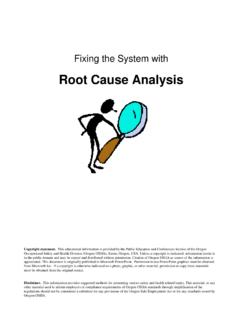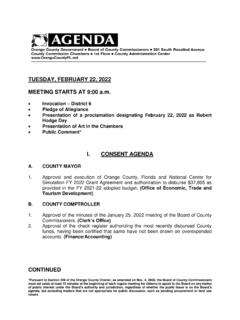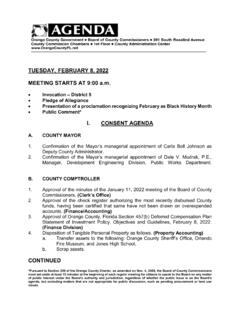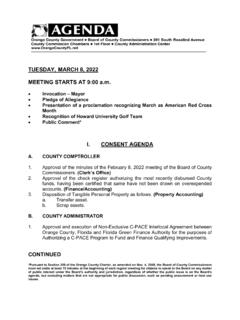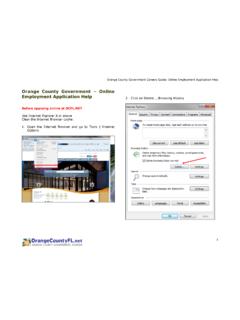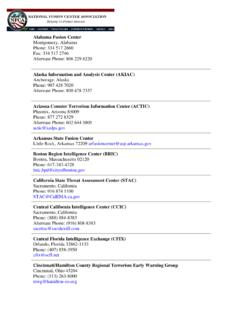Transcription of Fundamentals of Accident/Incident Prevention - OCFL
1 Section 4. Fundamentals of Accident/Incident Prevention Accidents/Incidents are Preventable Many people believe that accidents are the inevitable result of unchangeable circumstances, fate, or a matter of bad luck. Others believe that accidents happen to individuals with little or no common sense. The National Safety council has stated in previous articles that, 88% of all accidents are the result of unsafe acts of people. Approximately 10% of all accidents are caused by unsafe equipment or unsafe surroundings. The other 2% of all accidents are caused by Acts of God. It is important to emphasize that people make choices, those choices result in safe behaviors or risky behaviors not fate or bad luck.
2 It must also be emphasized that in most situations common sense or a lack of common sense is not the problem, people use values and past experiences in determining what set of actions to take. Those actions taken by the individual or individuals may result in an Accident/Incident or not. Accidents do not happen without causes, and the identification, isolation and control of Root Cause these causes are the underlying principles of all Accident/Incident Prevention techniques. To better understand the circumstances that give rise to the causes of accidents and incidents, it is helpful to consider the sources, these sources can be preexisting, potential or a combination. The sources can be reduced to three major elements.
3 Briefly the sources are the: Employee company, employee or supervisor's attitude or values; what someone does or fails to do; skill and/or educational level. Equipment guarding, improper guarding or lack of guarding; hot objects, heavy objects, irregular shaped or sharp objects and materials; improper, inadequate, inappropriate or defective equipment; inadequate maintenance or lack of maintenance; spacing of equipment; appropriate warnings. Environment illumination, noise, toxic substances, atmospheric conditions;. the safety culture. Safety and Health Manual Effective Date: September 19, 1997 Section 4. Revised Date: December 16, 2016 Page 1. Control of Hazards There are four main controls for an effective Accident/Incident Prevention program.
4 Engineering, Administrative, Personal Protective Equipment & Review. (a) Engineering Causes of accidents, or unsafe conditions, can sometimes be eliminated through the application of engineering controls. Design of machine guards, automobile brakes, traffic signals, pressure relief valves, general ventilation, local exhaust and hand rails are examples of safety engineering at work. (b) Administrative The risk of an accident or incident happening can be reduced or eliminated by administrative controls, for example: elimination or reduction of hazardous chemicals being introduced into the workplace;. hiring well educated or trained individuals; buying equipment with proper protective devices; removing the employee from direct contact.
5 Safety education is an effective tool in the Prevention . Through adequate instruction, personnel gain useful knowledge and can develop safe attitudes. (c) Personal Protective Equipment (PPE) protective equipment is used when hazardous conditions cannot be eliminated, reduced or isolated (in other words when engineering and administrative controls are not feasible or economical or during the interim when evaluating if controls would be feasible or economical). (d) Review Programs, policies and procedures should be reviewed and audited periodically to incorporate any changes or updates and to re- evaluate if the first two controls can be instituted. Eliminating Unsafe Conditions Employees shall report any unsafe condition to their supervisors and/or eliminate the unsafe condition, if possible.
6 The supervisor must take the initiative to abate unsafe conditions and protect employees and the public. If corrective action is beyond the supervisor's scope of authority, the matter must be brought to the attention of management and/or Risk Management. The following are examples of unsafe conditions that must not be permitted to exist: (a) Obstacles and impediments to the safe movement of personnel, vehicles or machines, such as blocked fire exits. (b) Forcing pedestrians to walk out onto roadways due to shoulder work (without the proper safeguards). (c) Unsafe working and walking surfaces. Holes in the walking or working surface that an individual can fall through or get their shoe stuck in.
7 Uneven floors (greater than inch), cracks in flooring (greater than inch) and uneven steps. Safety and Health Manual Effective Date: September 19, 1997 Section 4. Revised Date: December 16, 2016 Page 2. (d) Worn, damaged, or misused tools (cheater bars). (e) Operation of equipment without the proper protective machine guards. (f) Working without required protective equipment such as goggles, gloves, hard hats, adequate foot wear or seat belts. (g) Worn and/or damaged or unguarded electrical wiring, fixtures and power cords. (h) Absence of required signage warning of particular hazards in the area. Educating and training the workforce in the proper use of equipment and materials, awareness of their surroundings, and understanding their role in the workplace and in safety will aid in eliminating these occurrences.
8 One of the most effective means of preventing accidents/incidents is eliminating unsafe conditions through engineering controls, the second effective means is administrative controls the last effective control should be through the use of PPE. Near-Miss The important factor in eliminating unsafe conditions is doing so before an accident or incident occurs. Near-miss occurrences need to be investigated and corrected, as they are a warning of a condition that may eventually lead to an accident . A near-miss occurrence is an example of an incident resulting in neither an injury nor property damage. However, a near-miss occurrence has the potential to inflict injury or property damage if its cause is not corrected.
9 Job Safety Analysis/Risk Assessment Job Safety Analysis/Risk Assessments, break down the job into tasks/steps that are evaluated to identify any hazard for each task/step involved. Procedures for Job Safety Analysis/Risk Assessment are as follows: Job Hazard Analysis (a) List the sequence of job steps the job is broken down into basic steps, describing what is to be done in a logical sequence. (b) Search for and list potential hazards each step is analyzed for hazards that may cause an accident . The objective is to identify as many hazards as possible. (c) Decide on a recommended action or procedure to protect the employee from the hazards. When the risks and potential hazards associated with each step are identified and there causes understood, then methods of eliminating them should be outlined.
10 There are four basic methods by which this can be accomplished. Safety and Health Manual Effective Date: September 19, 1997 Section 4. Revised Date: December 16, 2016 Page 3. (1) Substitution Eliminate the hazardous process or operating and provide a substitute action. (2) Isolation Isolate the process or operation in order to eliminate or minimize the hazard. (3) Protection Provide appropriate engineering controls to minimize or eliminate hazards. (4) Personal Protective Equipment Provide and enforce use of personal protective equipment to reduce the possibility of injury or illness. The information collected from all of the above steps is used to create specific department safety policies and procedures.

